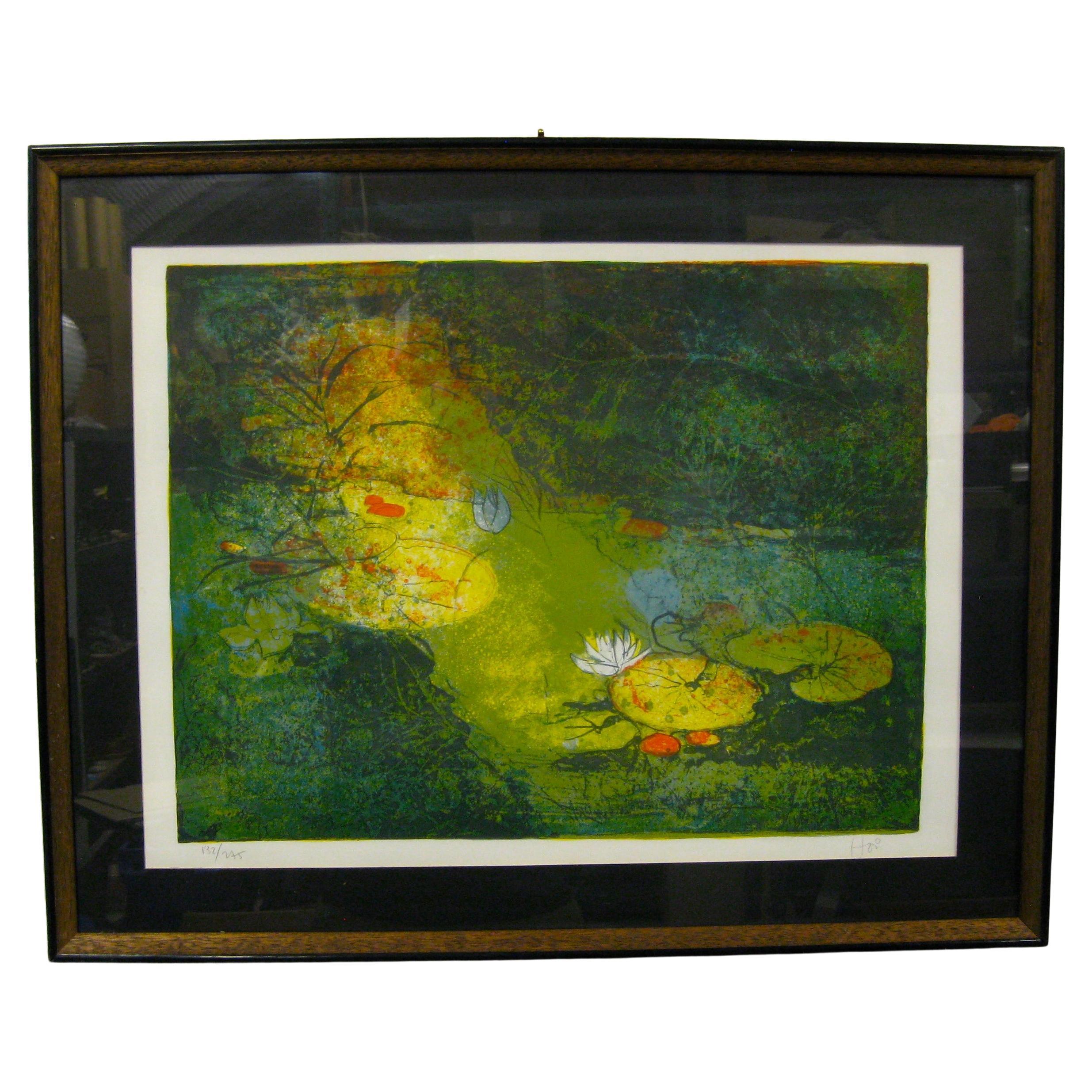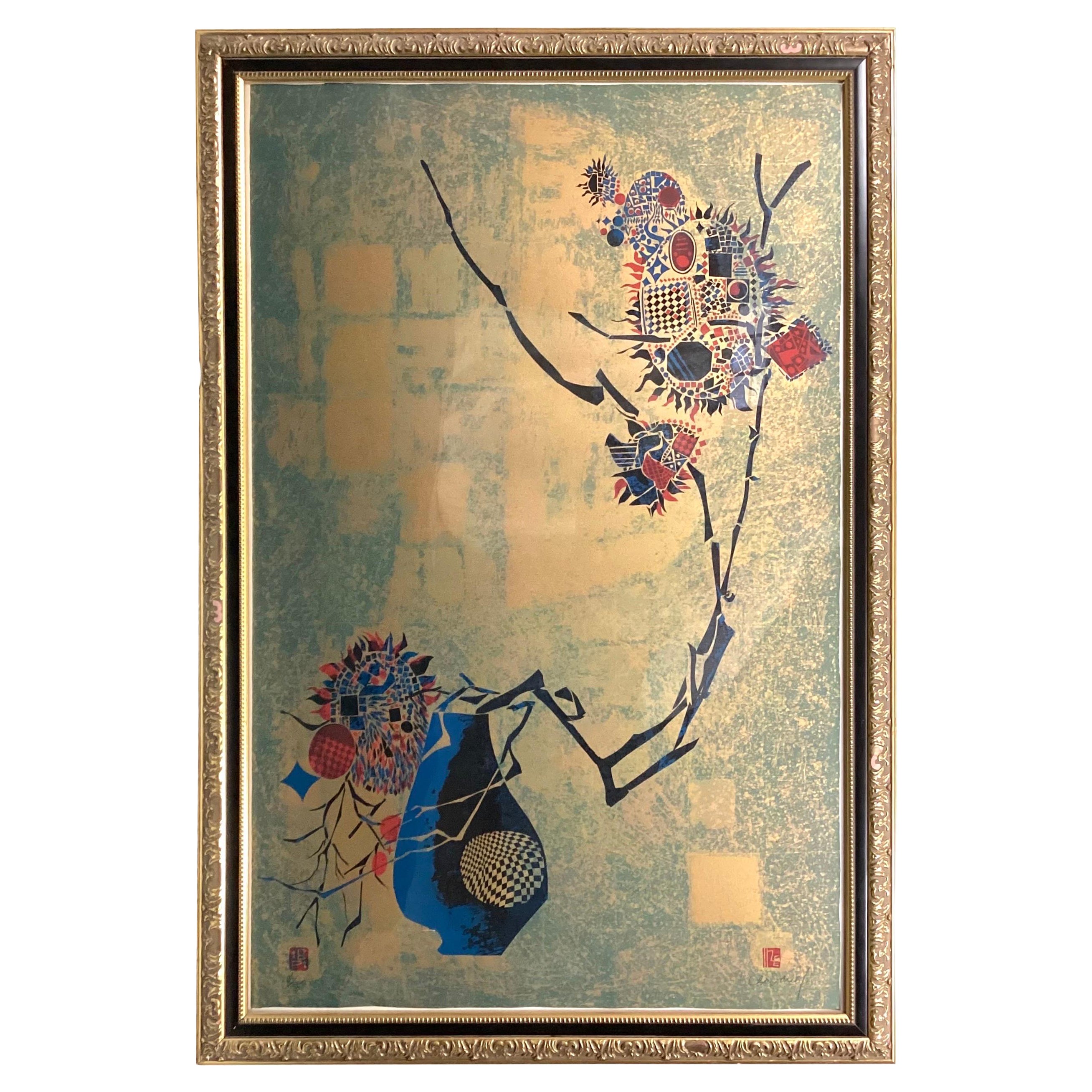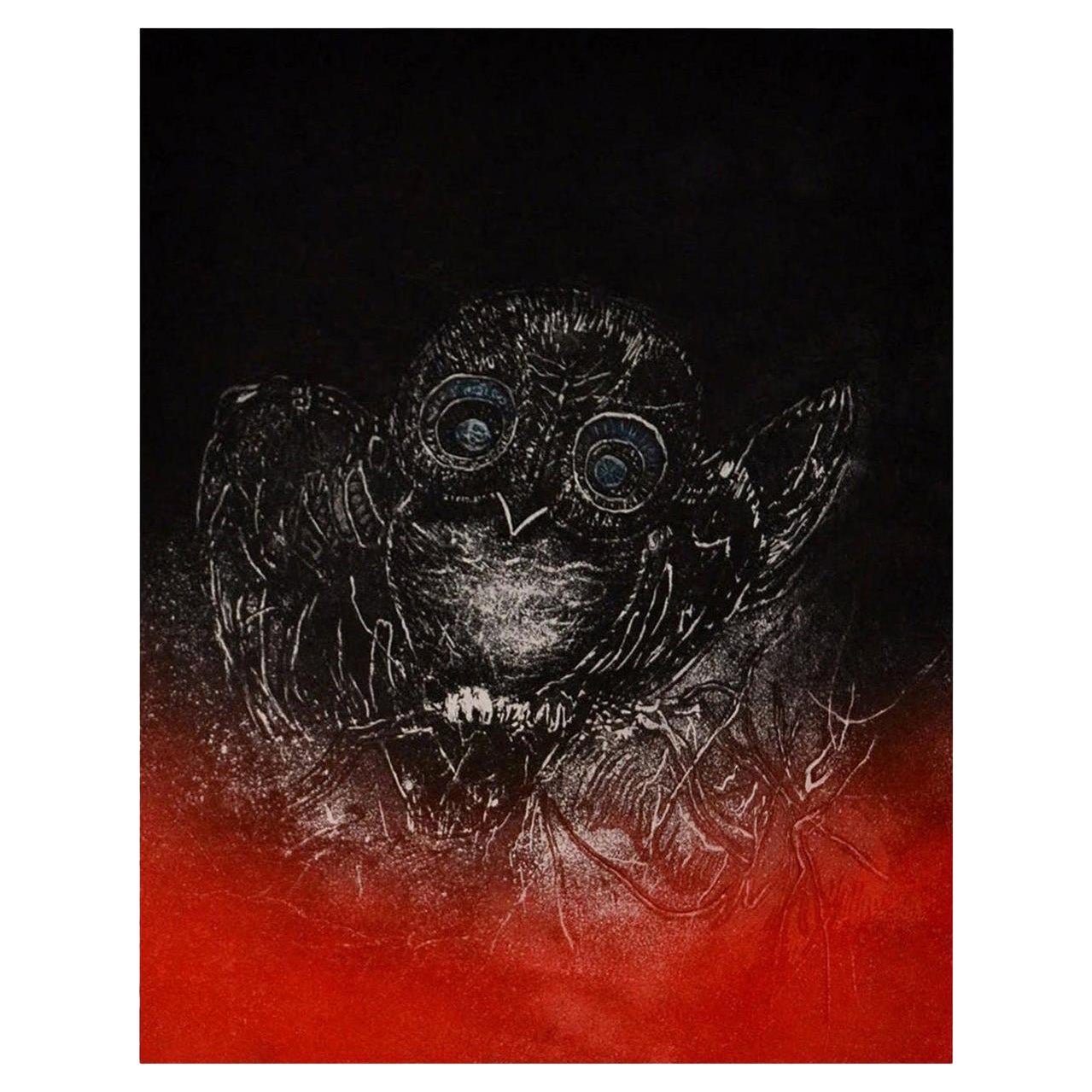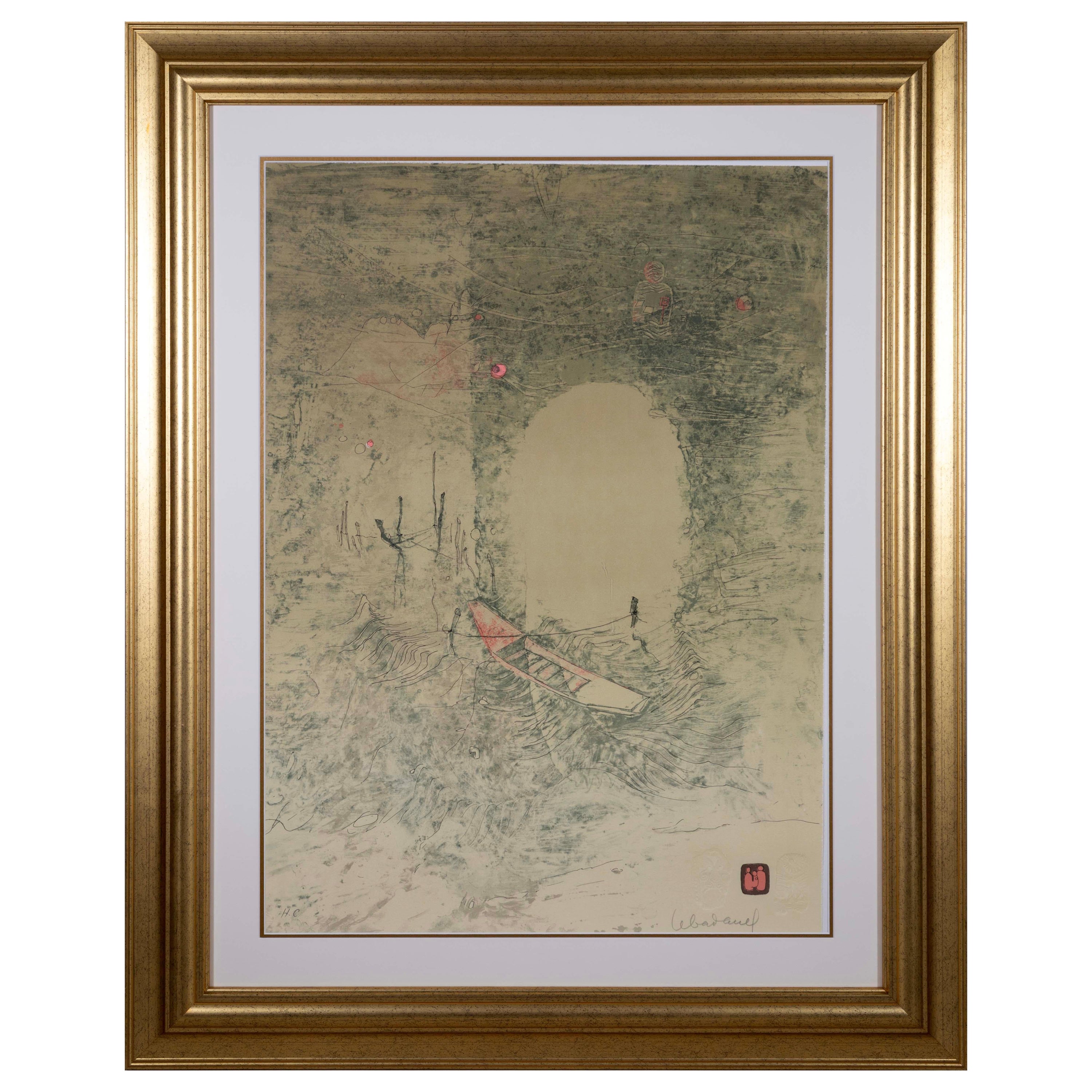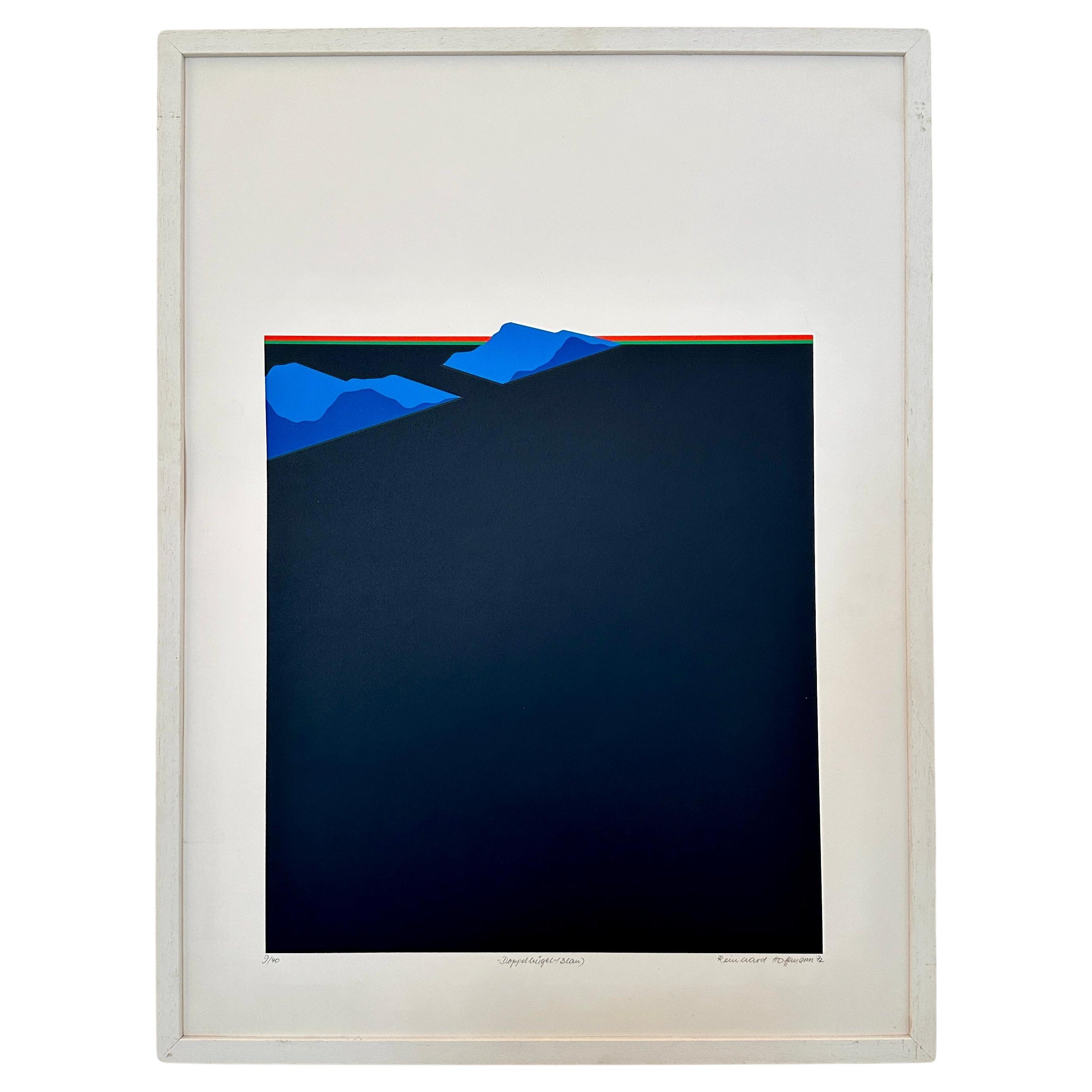Items Similar to Powerful Hoi Lebadang Abstract Mid Century Lithograph Signed and Numbered
Want more images or videos?
Request additional images or videos from the seller
1 of 10
Powerful Hoi Lebadang Abstract Mid Century Lithograph Signed and Numbered
About the Item
A mid 20th century lithograph print by Vietnamese / French artist Hoi Lebadang (1921 - 2015) signed and numbered. The colors employed, shades of red, white and charcoal set against a golden yellow, signify warmth and richness. The abstract composition beckons further inspection. The techniques used for creating this work of art include an embossed area of the work where the paper surface is raised in an abstract design. This work is presented in its original frame. I knew nothing of the artist when I bought this work, I simply knew that it appealed to me. A quick search online revealed this fascinating biography on the artist that I hope you'll read and enjoy. This comes from the Outside Folk Gallery website, "War shaped the life of Lebadang (Lê Bá Đảng.) Sometimes called Hoi Lebadang, this painter’s experiences in colonial-era Vietnam and WWII-era France flow into his work. Working at the turning point between 19th-century bohemianism and 20th-century modernism, he existed in two worlds simultaneously. The path that brought Lebadang to France in 1939 and secured his place in art history is complex. Looking at his childhood, you would never guess that this young Vietnamese boy would have such an impact on the art world. After shortening his name in 1950 to Lebadang, he only used Hoi when making lithographs. In colonial-era Vietnam, the French ruled Vietnam from the 1880s until 1954; France beckoned like a beacon for art and culture. Lê Bá Đảng (surname, middle name, given name), born in 1921, grew up with his eyes fixed on France. He grew up in a middle-class peasant family and, after primary school, felt the pull to travel. Lebadang signed on with the French Ministry of Labor, and when his father couldn’t cancel his underage son’s contract, he left for Marseille. What awaited him in Marseille wasn’t work. However, it was forced labor. Lebadang and his fellow shipmates became part of the war effort for World War II-era France. The ship unloaded its cargo into the prison at Baumettes and then into arms and munitions factories around the country. The government assigned him to 14 months of indentured servitude on arrival. After several attempts to escape, Lebadang found himself in the Lannemezan camp for discipline. Focusing on escape, he finally made it to the free zone in Toulouse, and this is where he began his art education. With nothing else to do and no resources, Lebadang signed up for an art class at École des beaux-arts (The School of Fine Arts) to fill the time. After his terrible experience as an indentured servant and prisoner, the free air of art school set him loose. He started working in graphic design for the local opera house and other organizations. When he graduated in 1948 from art school, he entered a design contest and won. With the funds from the competition, he did what every good artist did at the time and moved to Paris. Bohemian Paris proved a fertile creative ground for our young hero. His studio along rue de la Montagne-Sainte-Geneviève in the Latin Quarter’s heart provided him space to grow. In the 1950s, Lebadang started to exhibit his work around France. Then, in 1966, the well-established painter made his debut in the U.S. at the Cincinnati Art Museum. Lebadang worked in a wide range of media, including paint, watercolor, sculpture, jewelry, and graphic design. His most potent work combines mediums. Paint on rough burlap instead of canvas or foam-core paper carved and sandwiched between panes of glass. Lebadang’s career showed a serious artist unwilling to stop growing and changing. He worked up until his 90th year when he passed in 2015. Known for his painting and printmaking, his work powerfully captures his memories and impressions of life. A quote attributed to him by his wife Myshu captures him perfectly, “life is a sinking ship, and work is a lifeboat.” Lebadang’s work shows a vast range of creativity. His memories inspired him the most, from abstract paintings to more defined pieces. Lebadang’s work from the 1960s is brightly colored and ethereal. By the 1990s, his work became textured and used mixed media to show aerial views of landscapes. You can see the impact his schooling had on him, but his work also contains elements of Chinese and Vietnamese art... Lebadang’s paintings and prints fill the collections of some of the world’s finest institutions. Of course, you can find his work online with excellent analysis. But these are just a few spots where you can find his work in person. A fitting place to find Lebadang’s work, the Cernuschi Museum holds a vast collection of Asian art and sculpture. Located in the heart of Paris, the Vietnamese art collection has several pieces by Lebadang, including the Cosmic Family, nature-inspired paintings, and several abstract works. Fully immerse yourself in Lebadang’s visions in this Vietnam exhibition space/architectural experience. One of his long-term dreams, the Memory Space, fully realizes the environment Lebadang wanted for his body of work. The building opened to the public in 2019. First conceived in 1985, the building provides a place of contemplation and meditation. Like much of Lebadang’s work, the impressions one gathers are part of the experience. Working with his widow, designers used one of his aerial landscapes to inform the museum’s design. Lebadang lived through some of the most difficult parts of modern history. Despite a rough beginning, he overcame the challenges of a new country, prison, and war. He provides a welcome respite from a chaotic world through his meditative paintings. A vibrant and never-stagnant artist, his place in the art world is certainly secure."
- Creator:Hoi Lebadang (Artist)
- Dimensions:Height: 23 in (58.42 cm)Width: 31.25 in (79.38 cm)Depth: 0.5 in (1.27 cm)
- Style:Mid-Century Modern (Of the Period)
- Materials and Techniques:
- Place of Origin:
- Period:
- Date of Manufacture:1960's
- Condition:Wear consistent with age and use. In good vintage condition with age appropriate wear. This work has not been examined out of the frame.
- Seller Location:Atlanta, GA
- Reference Number:1stDibs: LU7240235004642
About the Seller
5.0
Vetted Seller
These experienced sellers undergo a comprehensive evaluation by our team of in-house experts.
Established in 2002
1stDibs seller since 2022
60 sales on 1stDibs
Typical response time: <1 hour
- ShippingRetrieving quote...Ships From: Atlanta, GA
- Return PolicyThis item cannot be returned.
More From This SellerView All
- Mid-20th Century Outsider Art Automatic Writing Mixed-Media Collage, FramedLocated in Atlanta, GAA vintage outsider art style collage exhibiting (what I believe to be) an example of ‘automatic writing’. From Wikipedia: “Surrealist automatism i...Category
Mid-20th Century American Mid-Century Modern Prints
MaterialsPaper
- 19th Century English Tinsel Print Portrait of Actor Retailed Saxon and ClemensLocated in Atlanta, GAA mid 19th century English full length portrait tinsel print hand colored and hand embellished, framed and retailed by Saxon and Clemens of New York City circa mid 20th century. This print depicts, "Mr. Freer as Marmion". This is one of three tinsel prints that I have available on my HKFA storefront here on 1stdibs. From the Robertson Davies Collection website, I would like to share with you this fascinating history of tinsel prints, "As the popularity of these prints became wide spread, bags of prepared tinsel decorations were sold along with the prints making them customizable by the purchaser. Thus after the tinseling process, no two prints would be identical. Tinsel prints emerged from the tradition of toy theatres. Once an appropriate model theatre was purchased, the public could buy prints depicting actors, actresses and scenery from plays that were being performed at the time and recreate those plays in their home. As the "juvenile drama" became popular, play books were published along side prints so the words of the plays could be recreated as well. While the genre flourished the desire to purchase a larger print of a specific actor or actress remained. Thus two types of theatrical prints became to be printed: those for juvenile dramas that were small and excluded specific actors names, and actors portraits that were larger and more individualized. In the larger theatrical portraits, characters were "always displayed full length" and "striking [a] habitual and dramatic pose". The 1830's marked the emergence of tinseling prints as a past time. Before this time, if an individual wished to embellish a portrait, individual sheets of metal foil would have to be purchased, measured and cut to fit an individual print. Once tinseling became common, different packages of precut tinsel (specific to the print)would be sold with each print as aforementioned. The term tinsel specifically refers to the metal sheets used to represent armor and weapons, but more broadly includes pieces of satin, silk, velvet, leather, and feathers among other embellishments. Although tinsel prints are now viewed as works of art, in the nineteenth century they were no more than a child's pastime. Most sources cite tinseling, as well as toy theatre, as being most popular among boys from the working class. Their popularity among boys could explain why male portraits were produced more frequently than female, however, it is more likely that male costumes, with their multiple pieces of armor and arms...Category
Antique Mid-19th Century English Prints
MaterialsMetal, Brass, Foil
- 19th Century English Tinsel Print Portrait of Actor Retailed Saxon and ClemensLocated in Atlanta, GAA mid 19th century English full length portrait tinsel print hand colored and hand embellished, framed and retailed by Saxon and Clemens of New York City (original paper backing has been lost to time, however this print is similar to two others both from Saxon and Clemens) circa mid 20th century. This print depicts, "Mr. Collins as Sir Reginold the Bold in the Giant of Palestine". This is one of three tinsel prints that I have available on my HKFA storefront here on 1stdibs. From the Robertson Davies Collection website, I would like to share with you this fascinating history of tinsel prints, "As the popularity of these prints became wide spread, bags of prepared tinsel decorations were sold along with the prints making them customizable by the purchaser. Thus after the tinseling process, no two prints would be identical. Tinsel prints emerged from the tradition of toy theatres. Once an appropriate model theatre was purchased, the public could buy prints depicting actors, actresses and scenery from plays that were being performed at the time and recreate those plays in their home. As the "juvenile drama" became popular, play books were published along side prints so the words of the plays could be recreated as well. While the genre flourished the desire to purchase a larger print of a specific actor or actress remained. Thus two types of theatrical prints became to be printed: those for juvenile dramas that were small and excluded specific actors names, and actors portraits that were larger and more individualized. In the larger theatrical portraits, characters were "always displayed full length" and "striking [a] habitual and dramatic pose". The 1830's marked the emergence of tinseling prints as a past time. Before this time, if an individual wished to embellish a portrait, individual sheets of metal foil would have to be purchased, measured and cut to fit an individual print. Once tinseling became common, different packages of precut tinsel (specific to the print)would be sold with each print as aforementioned. The term tinsel specifically refers to the metal sheets used to represent armor and weapons, but more broadly includes pieces of satin, silk, velvet, leather, and feathers among other embellishments. Although tinsel prints are now viewed as works of art, in the nineteenth century they were no more than a child's pastime. Most sources cite tinseling, as well as toy theatre, as being most popular among boys from the working class. Their popularity among boys could explain why male portraits were produced more frequently than female, however, it is more likely that male costumes, with their multiple pieces of armor and arms...Category
Antique Mid-19th Century English Prints
MaterialsFoil, Brass, Metal
- 19th Century English Tinsel Print Portrait of Actor Retailed Saxon and ClemensLocated in Atlanta, GAA mid 19th century English full length portrait tinsel print hand colored and hand embellished, framed and retailed by Saxon and Clemens of New York City circa mid 20th century. This print depicts, "Mr. Freer as Alonzo the Patriot". This is one of three tinsel prints that I have available on my HKFA storefront here on 1stdibs. From the Robertson Davies Collection website, I would like to share with you this fascinating history of tinsel prints, "As the popularity of these prints became wide spread, bags of prepared tinsel decorations were sold along with the prints making them customizable by the purchaser. Thus after the tinseling process, no two prints would be identical. Tinsel prints emerged from the tradition of toy theatres. Once an appropriate model theatre was purchased, the public could buy prints depicting actors, actresses and scenery from plays that were being performed at the time and recreate those plays in their home. As the "juvenile drama" became popular, play books were published along side prints so the words of the plays could be recreated as well. While the genre flourished the desire to purchase a larger print of a specific actor or actress remained. Thus two types of theatrical prints became to be printed: those for juvenile dramas that were small and excluded specific actors names, and actors portraits that were larger and more individualized. In the larger theatrical portraits, characters were "always displayed full length" and "striking [a] habitual and dramatic pose". The 1830's marked the emergence of tinseling prints as a past time. Before this time, if an individual wished to embellish a portrait, individual sheets of metal foil would have to be purchased, measured and cut to fit an individual print. Once tinseling became common, different packages of precut tinsel (specific to the print)would be sold with each print as aforementioned. The term tinsel specifically refers to the metal sheets used to represent armor and weapons, but more broadly includes pieces of satin, silk, velvet, leather, and feathers among other embellishments. Although tinsel prints are now viewed as works of art, in the nineteenth century they were no more than a child's pastime. Most sources cite tinseling, as well as toy theatre, as being most popular among boys from the working class. Their popularity among boys could explain why male portraits were produced more frequently than female, however, it is more likely that male costumes, with their multiple pieces of armor and arms...Category
Antique Mid-19th Century English Prints
MaterialsBrass, Foil
- 1964 Dieter Rot Double Sided Black and White Geometric Die Cut Print, FramedBy Dieter Roth 1Located in Atlanta, GAA vintage circa 1964 double sided die cut print by Dieter Rot (Dieter Roth 1930-1998). This double sided die cut print was part of promotional material sent...Category
Mid-20th Century American Mid-Century Modern Prints
MaterialsGlass, Paper
- 1964 Dieter Rot Double Sided Black and White Geometric Die Cut Print, FramedBy Dieter Roth 1Located in Atlanta, GAA vintage circa 1964 double sided die cut print by Dieter Rot (Dieter Roth 1930-1998). This double sided die cut print was part of promotional material sent...Category
Mid-20th Century American Mid-Century Modern Prints
MaterialsGlass, Paper
You May Also Like
- 1970's, Hoi Lebadang Abstract Lithograph Print "Water Lilies" Signed & NumberedBy Hoi LebadangLocated in San Diego, CAWonderful hand signed and numbered abstract lithograph by listed Vietnamese Hoi Lebadang, circa 1970's. The abstract lithograph features colorful w...Category
Mid-20th Century American Prints
MaterialsPaper
- Large Hoi Lebadang Rare Lithograph Framed Signed & NumberedBy Hoi LebadangLocated in Lambertville, NJLarge Hoi LeBaDang rare lithograph framed. Signed and numbered in pencil 51/250. Lebadang, Vietnamese (1922–2015) Lithograph, Overall Size 36" wide by 52" Tall. Some minor age-approp...Category
Vintage 1970s French Prints
MaterialsPaper
- Artist Hoi Lebadang Signed LithographLocated in BROOKLYN, NYModern lithograph by Hoi Lebadang featuring a lovers embrace and herding bird details. Beautiful red hues. Limited edition (301/375) with a collectors edition certificate of aut...Category
Mid-20th Century American Mid-Century Modern Prints
MaterialsPaper
- Hoi Lebadang Signed Vietnamese French Lithograph Print of OwlLocated in Studio City, CAA rare and hard to find owl image by Vietnamese born renowned French printmaker / artist Hoi Lebadang. The print is pencil signed and noted as artist proof in French by the artist...Category
20th Century French Modern Prints
MaterialsPaper
- Lebadang Boat at Docks Signed Modern Lithograph with Intaglio H.C. FramedBy Hoi LebadangLocated in Keego Harbor, MIA calming and serene modern lithograph on rice paper titled "Boat at Docks" by Vietnamese-French artist Lebadang. Signed in pencil on the bottom right with an H.C. annotation on the ...Category
20th Century Prints
MaterialsPaper
- Mid Century Abstract Color Lithography signed and numbered, 1970sLocated in Berlin, DECrafted during the vibrant 1970s, this Mid Century Abstract Color Lithography, signed and numbered, is a testament to the era's artistic dynamism. The lithograph bursts with bold col...Category
Vintage 1970s German Mid-Century Modern Prints
MaterialsCut Glass, Oak, Lacquer, Paper
